I know that you need a break from messy spreadsheets. It’s an everyday headache that you face when managing multiple projects. I mean, who doesn’t want a visual planner that combines tasks and the calendar so that you can keep track of stuff exactly as needed?
And if calendar apps seem too limited for your requirements, I know exactly what you need – calendar task management software.
These are project or task managers that come with an integrated calendar view – a divine combo to track deadlines and pending works!
Here’s a glance at the top 10 calendar project management software solutions.
| Calendar Project Management Tools | Best For | Pricing Starts From |
| ProProfs Project | Simplified Project Management | $39.97/month |
| ClickUp | Generating Detailed Reports | $7/member/month |
| Smartsheet | Real-Time Project Collaboration | $7/user/month |
| Asana | Strategic Project Planning | $10.99/user/month |
| Nifty | Project Portfolio Management | $39/month |
| ProjectManager | Agile Project Management | $13/user/month |
| Wrike | Automating Administrative Workflows | $9.80/user/month |
| Notion | Building Product Roadmaps | $8/user/month |
| Hive | Flexible Project Hierarchies | $1/user/month |
| Bitrix | Remote Task Management | $49/month (for 5 users) |
Which Is the Best Calendar Task Management Software?
All the tools listed above have calendar views to manage tasks. So, which tool is the best for you depends on what other requirements or expectations you have from the project management software.
If you ask me about my top three picks from the list, then it would look something like this:
Option A: ProProfs Project
This user-friendly calendar project management tool simplifies team collaboration. With a seamless calendar view allowing easy task adjustments and Google Calendar synchronization, it ensures efficient project tracking. Additionally, the software facilitates team communication and file sharing and provides analytics for effective project management.
Option B: Notion
Notion, a versatile project management tool, offers customizable calendar templates for efficient note, document, and task management. Its standout feature is constructing detailed product roadmaps that seamlessly connect vision, goals, and features, allowing organized prioritization with tags, filters, and linking capabilities.
Option C: Asana
Asana is popular for its effective organization of tasks and deadlines, along with a standout calendar view. The tool aids proactive planning and workload prioritization. Asana goes beyond excelling in strategic project planning, enabling goal setting, progress tracking, and ensuring team cohesion for achieving significant results aligned with company objectives.
List of Calendar Task Management Software
The list of tools below has been sourced primarily from market leaders (project managers, team leaders, directors) who use them as their daily drivers.
I also included data gathered from software review sites and peer recommendations to have a diverse understanding of different perspectives. Lastly, I incorporated my personal experience to present an in-depth comparison of the tools to help you make an informed decision.
Let’s get started.
1. ProProfs Project – Best for Simplified Project Management
(Image Source: ProProfs Project)
This is one of those calendar project management tools that remind you how software is supposed to make things easier for your team. Having used it for more than a year, I can vouch for its simplicity.
But first things first – the calendar view.
I’ve used the tool for several projects, and I simply love its calendar view. It enables me to see all tasks and milestones in a single glance. It lets you drag and drop tasks to adjust their timelines and sync them with Google Calendar. I use the calendar view to avoid missing any deadlines.
Using the software, you can communicate with your team using task comments, share files and feedback, and get email notifications for updates. It also generates smart reports and analytics to measure project performance and identify any potential risks.
What you’ll like:
- Generates timesheets for each task by recording time manually or automatically
- Instant invoices for clients based on the time and expenses tracked
- Workflow management software feature lets you customize the layout, status, and fields to suit your needs
- Manages multiple projects and prioritizes them according to your strategic goals
- Resource planning to allocate and match people with relevant skills to projects
What you may not like:
- There could have been more than 15 days of free trial to explore the software entirely
- You don’t get an option to switch between dark and light modes
Pricing: Starts at $39.97/month. Unlimited users, projects & tasks.
2. ClickUp – Best for Generating Detailed Reports
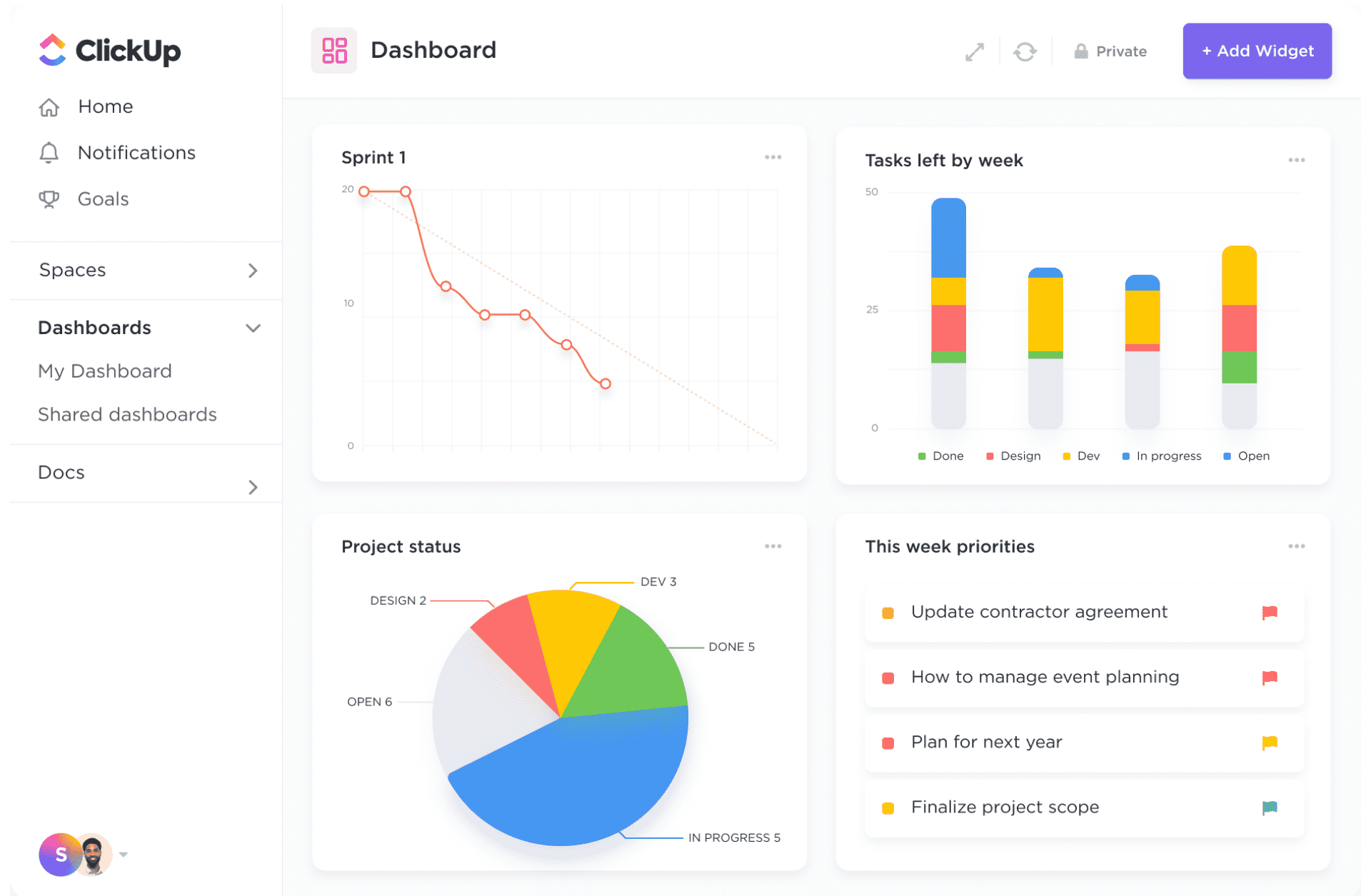
(Image Source: ClickUp)
If you’re looking for a detailed project calendar in project management software, ClickUp can be a good choice.
The software lets you plan tasks, events, and goals on a beautiful and interactive calendar. You can sync it with other apps, drag and drop tasks to reschedule them, and view your workload by day, week, month, or year – it’s that simple!
ClickUp is also well-known for its ability to generate detailed reports with dashboards.
Dashboards are customizable and interactive panels that display project data from various sources. You can choose from multiple widgets to build a perfect dashboard, such as custom charts, progress tracking, calculations, time tracking, etc.
With dashboards, you can track real-time progress, surface deeper insights, and gain high-level work overviews.
What you’ll like:
- A scalable structure to organize work into Spaces, Folders, and Lists
- Actions, triggers, and conditions to automate routine work and processes
- Hundreds of templates for team use cases, views, tasks, checklists, Docs, etc.
- A visual database that lets you link tasks, documents, integrations, etc.
- A feedback tool that lets you annotate, comment, and approve images and PDFs
What you may not like:
- Only 100 MB of storage space in the free plan
- Some users report that the ClickUp app on Android devices is slow
Pricing: A free plan is available with limited storage space. Paid options start at $7/member/month.
3. Smartsheet – Best for Real-Time Project Collaboration
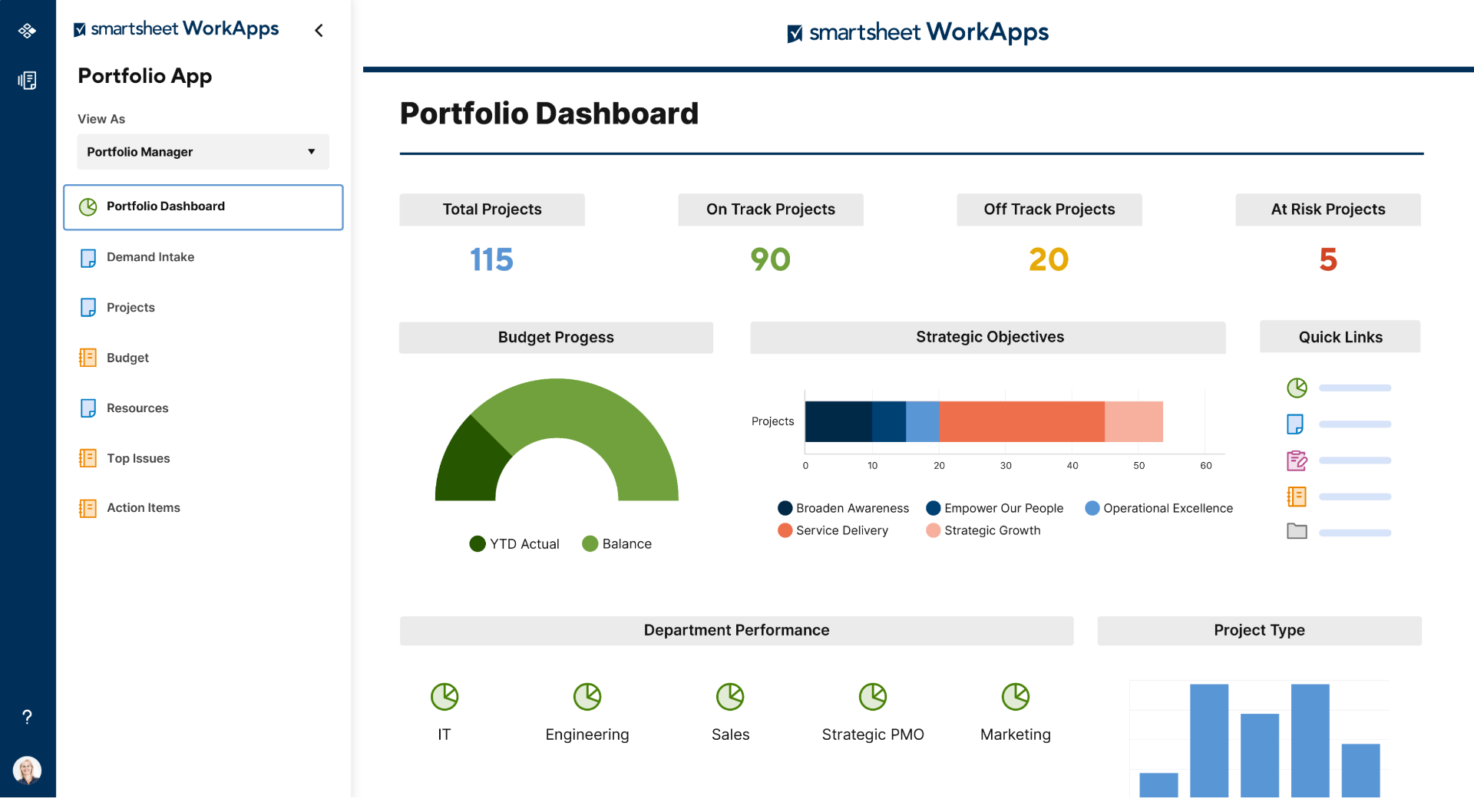
(Image Source: Smartsheet Community)
For those who like the spreadsheet-like UI, Smartsheet can be a great calendar task management software option.
The calendar view is a great way to see tasks and deadlines in a visual and interactive way. I found that the software lets you switch to the calendar view from any sheet or report that has at least one date column. I can also choose to display date ranges by selecting two date columns in a sheet. This is helpful, especially when tracking the progress of tasks.
Apart from that, Smartsheet is also popular for its real-time project collaboration capabilities.
You can share sheets with anyone (from team members to external stakeholders) and control their access permissions. The tool also lets you communicate with them through comments, alerts, and reminders and attach files from Google Drive, Dropbox, or OneDrive.
What you’ll like:
- Customizable dashboards for real-time project visibility
- Task tracking and scheduling capabilities for efficient project execution
- File sharing and document management for centralized project information
- Budgeting and financial tracking functionalities for cost management
- Audit trail and historical data tracking for accountability and compliance
What you may not like:
- Only 500 MB of attachment storage in the free plan
- Pages do not update in real time for collaborative work
Pricing: A free plan is available with limitations to sheets to track projects and tasks. Paid options start at $7/user/month.
4. Asana – Best for Strategic Project Planning
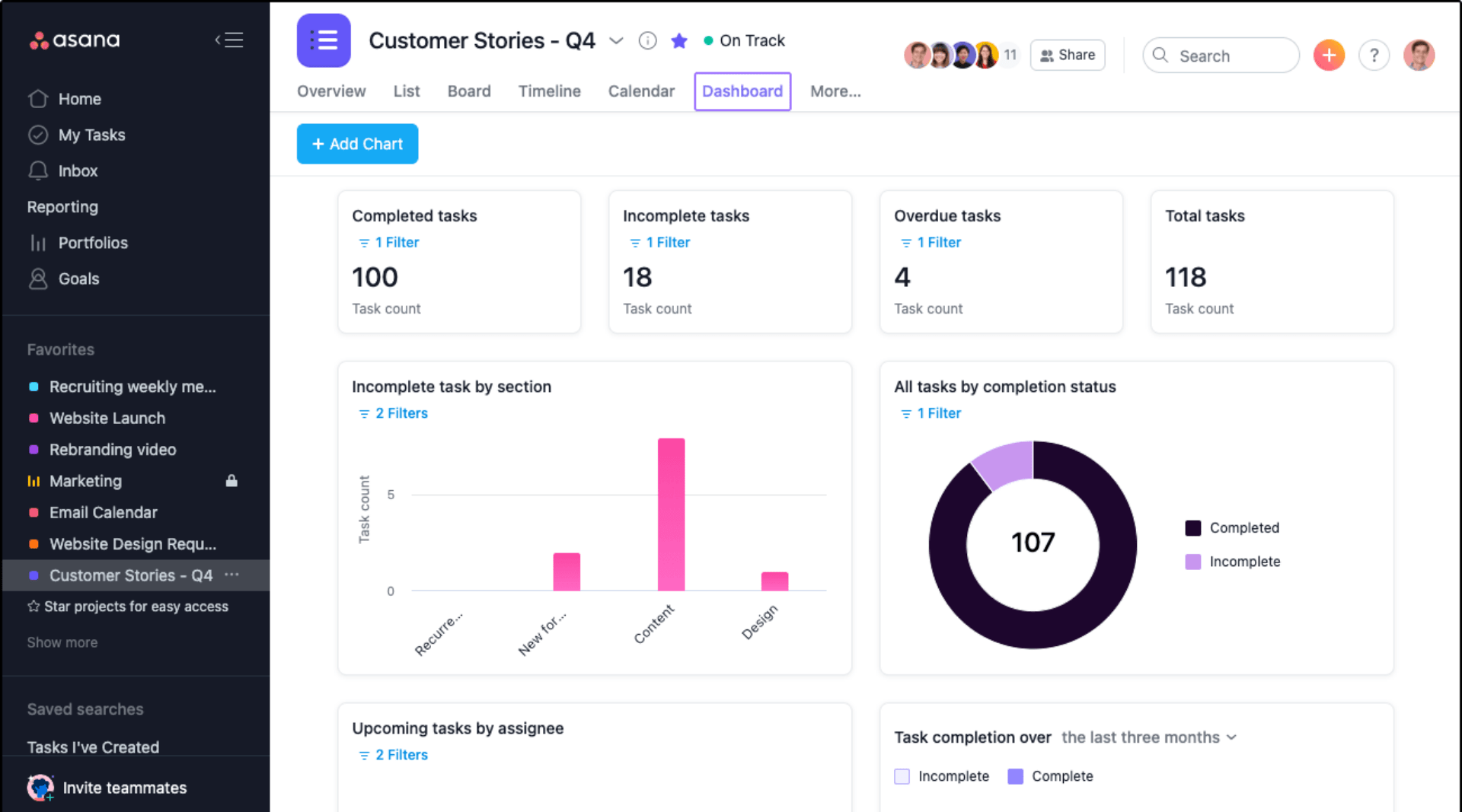
(Image Source: Asana)
I’ve used Asana previously, and I appreciate its effectiveness in keeping me organized with my projects and deadlines.
Among its features, the calendar view stands out as a favorite, providing a visual representation of all my tasks and milestones. It assists me in proactive planning, identifying possible conflicts, and prioritizing my workload.
But that’s hardly all.
Asana is really good for strategic project planning. It helps you make sure your work fits with what your company wants to achieve. You can set goals, track how things are going, and make sure your team is working well together. By using Asana, you can make your big plans actually happen and achieve important results.
What you’ll like:
- Multiple project views, such as list, calendar, timeline, Gantt chart, and Kanban board
- Custom fields, forms, rules, templates, and bundles to automate work processes
- Real-time reporting dashboards and status updates to monitor progress
- Admin console for managing team settings and security
- Integration support with other apps through its open API and native integrations
What you may not like:
- Not ideal for graphics-intensive work or software development projects
- May have performance issues when handling large or complex projects
Asana Pricing Plan: A free plan is available with limitations to features like Gantt charts, project goals, portfolios, etc. Paid options start at $10.99/user/month.
5. Nifty – Best for Project Portfolio Management
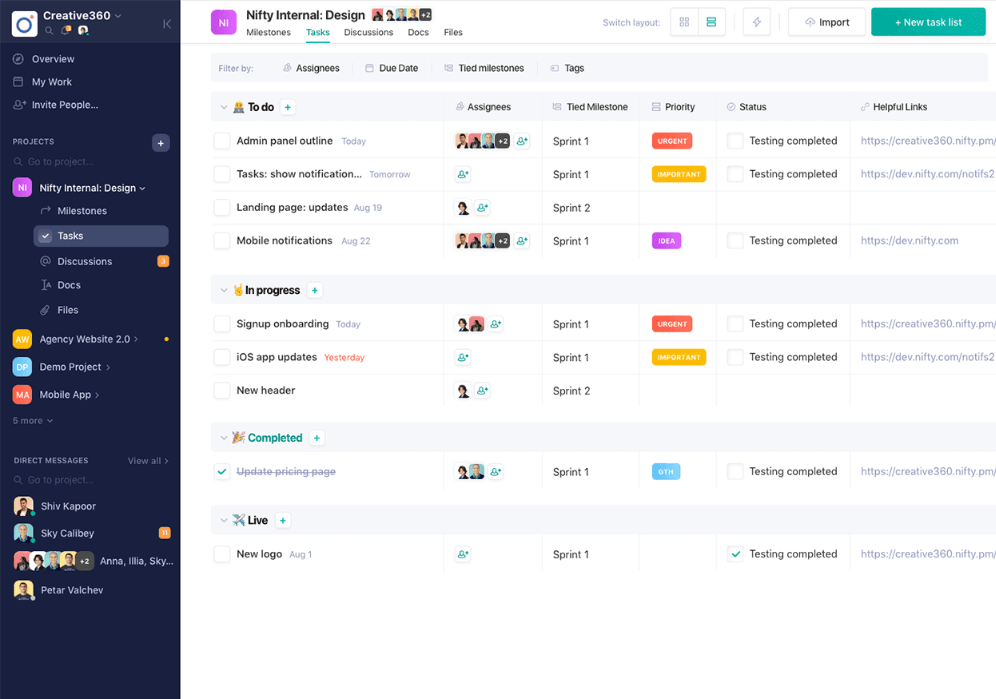
(Image Source: Nifty)
Nifty is another calendar project management tool you may like checking out.
It helps you plan your tasks for the day, week, or month using calendars. You can easily schedule them by dragging and dropping them and using filters to sort them by status, priority, or person assigned. I think it’s pretty useful if you want to make sure your tasks fit with important events and milestones.
I also found Nifty to be decent for project portfolio management.
It enables you to create and manage multiple portfolios – each with distinct goals, budgets, and resources. You can also monitor the progress, performance, and health of each portfolio with real-time data and insights.
What you’ll like:
- Portfolio management for organizing projects into folders and viewing automated progress
- Different user roles and permissions for controlling access and visibility of projects
- Project discussions for communicating with team members and clients in real time
- File proofing for reviewing and approving files with comments and annotations
- Custom fields for adding extra information and filters to your tasks
What you may not like:
- No option to export or print reports, documents, or tasks
- Only 100 MB of storage space in the free plan
Pricing: A free plan is available with a limitation on storage space. Paid options start at $39/month.
6. ProjectManager – Best for Agile Project Management
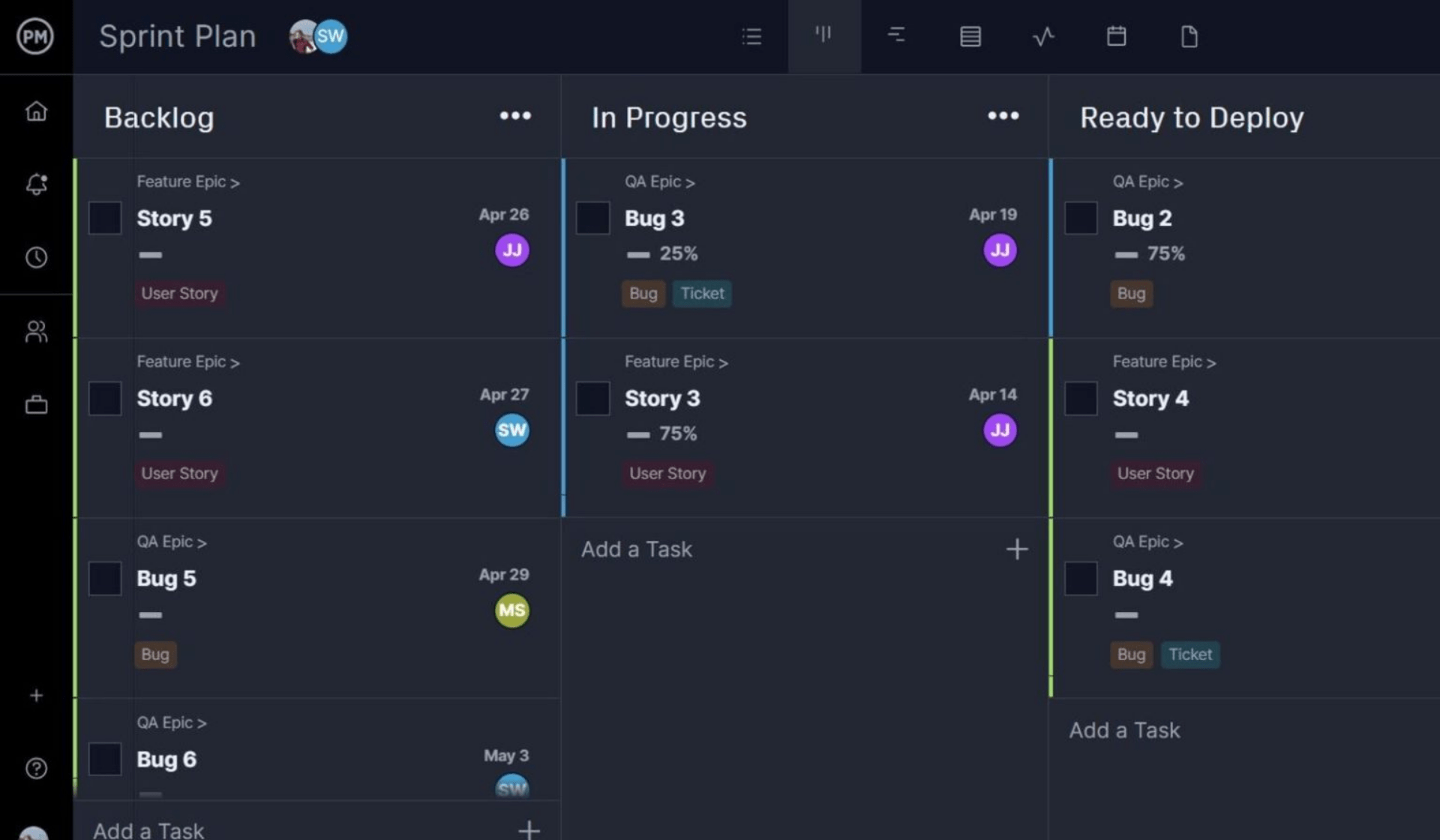
(Image Source: ProjectManager)
With ProjectManager’s calendar view, you can see and change project tasks over time. You can also choose how to show your tasks: by dates, names, or assignees. The software lets you filter and sync tasks with other calendars.
However, more than as a calendar task management software solution, you may like ProjectManager for its agile project management. I’ll explain you briefly.
The software enables teams to efficiently manage backlogs, create workflows, and execute sprints. With its hybrid offering of Gantt charts, kanban boards, and advanced reports, ProjectManager provides the agility, accuracy, and insights needed for successful agile project management.
What you’ll like:
- Kanban boards to organize work with drag-and-drop cards
- Project timesheets for easy time tracking and approval
- Task scheduling and workload review across all projects
- Reports for project performance, variance, workload, timesheets, etc.
- Resource management for scheduling, allocating, and tracking resources
What you may not like:
- No risk management or workflow automation in the free plan
- Inability to customize the print options for the Gantt chart
Pricing: Starts at $13/user/month.
7. Wrike – Best for Automating Administrative Workflows
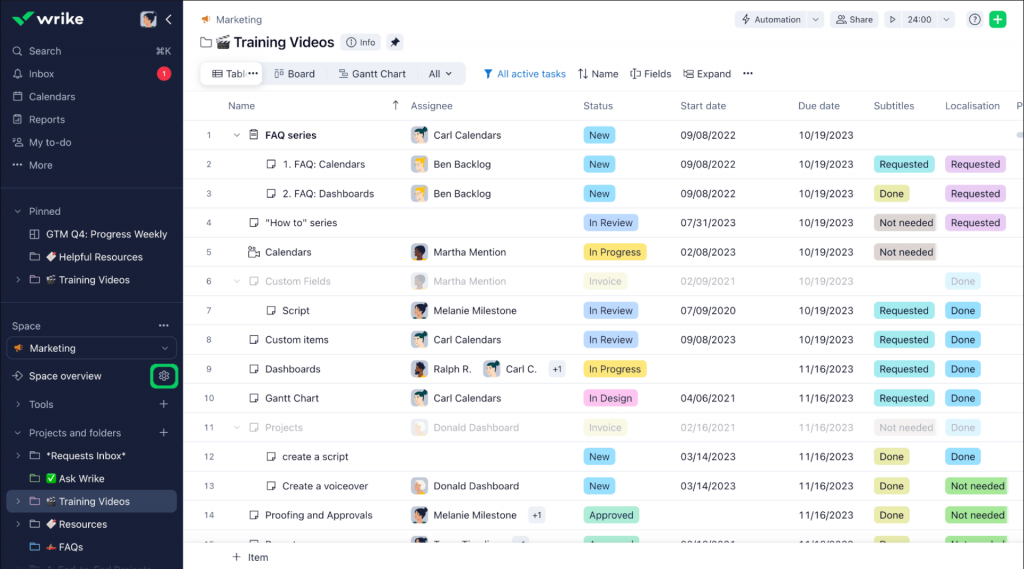
(Image Source: Wrike)
Wrike is a popular project management software – perfect for creating campaigns, tracking billable hours, planning strategically, or optimizing IT workflows.
I really like Wrike’s calendar views for a number of reasons. It lets me see all tasks and deadlines in one place and easily adjust them with a drag-and-drop functionality. I can also filter the calendar by project, status, assignee, etc., to get a clear overview of workload and priorities.
Wrike excels in administrative workflow automation. You can create automatic approvals, request forms, and repeatable blueprints for repetitive processes. Rules and triggers can be set for actions such as sending emails, setting up reminders, and assigning tasks.
What you’ll like:
- Dynamic request forms to automate work intake
- Pre-built templates to get projects up and running in no time
- Custom item types to work your way with a fully configurable workspace
- Calendar view to quickly display work items and keep track of deadlines
- Custom dashboards with widgets and charts to monitor your team’s performance
What you may not like:
- No calendar views, dashboards, or real-time reports in the free plan
- Steep learning curve for new users to get familiar with the interface and its terminologies
Pricing: A free plan is available with limited storage space. Paid options start at $9.80/user/month.
8. Notion – Best for Building Product Roadmaps
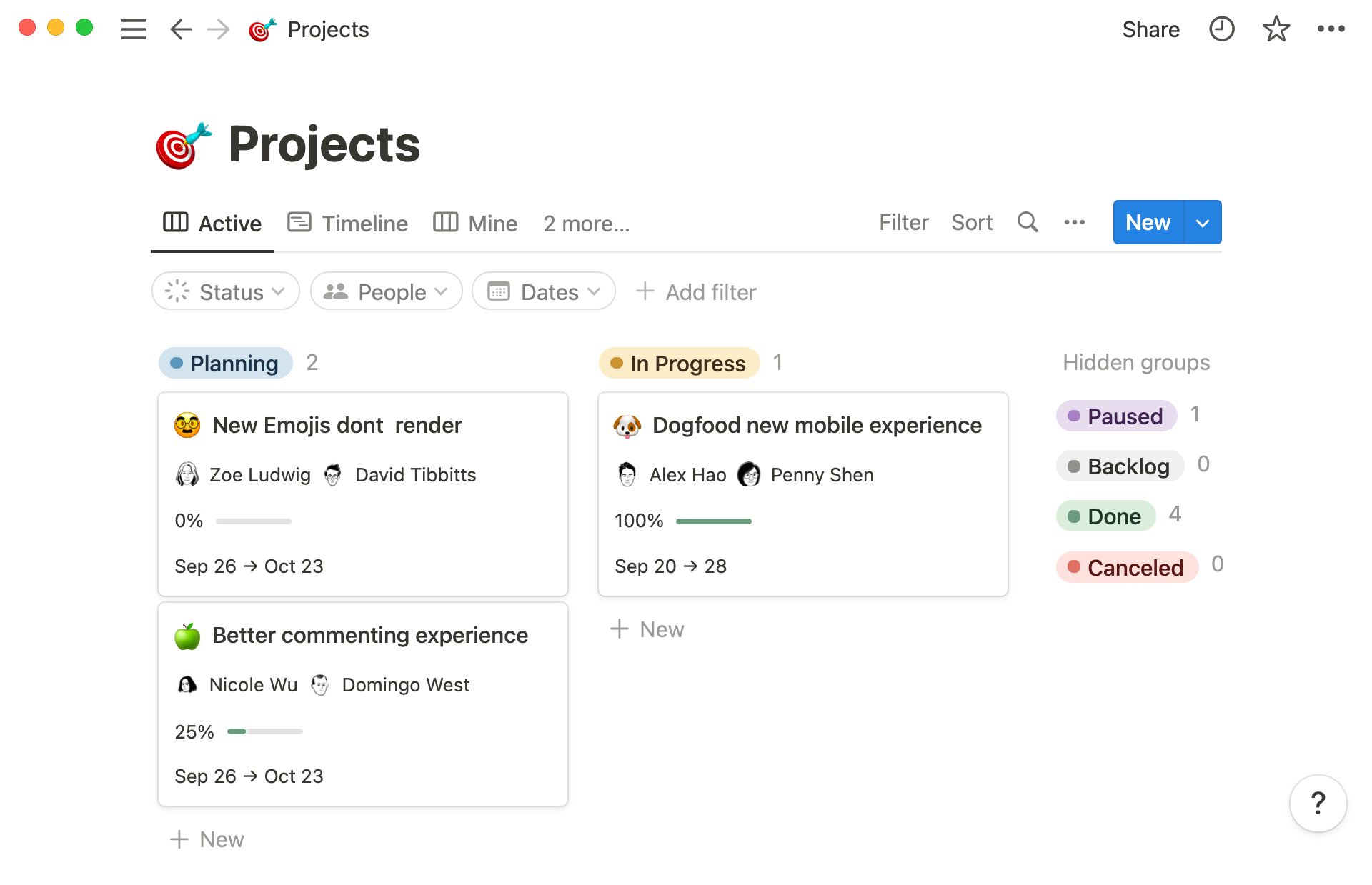
(Image Source: Notion)
Notion is another project management software that lets you manage notes, documents, tasks, etc.
I liked its arsenal of project management calendar templates. I could use these templates, customize them, and check deadlines, events, and goals at a glance. It’d also let me easily switch between different views, such as list, board, table, or timeline.
But what I think the software excels at is building product roadmaps. It connects product vision, goals, and features to the actual work that needs to be done. You can use tags, filters, and sorts to organize and prioritize the roadmap and link it to other pages, such as documentation, feedback, or testing.
What you’ll like:
- Advanced task management options, including recurring tasks and multi-select commands
- Inline editing for quick updates and changes to project documents
- Linked databases that allow for better data organization and cross-referencing
- Multiple layout options for organizing project documents and data
- Advanced permissions settings for controlling access to project information
What you may not like:
- Only 5 MB of file upload storage allowance in the free plan
- Some users report having limited offline functionality and sync issues, which can cause data loss
Pricing: A free plan is available for only up to 10 guest collaborators. Paid options start from $8/user/month.
9. Hive – Best for Flexible Project Hierarchies
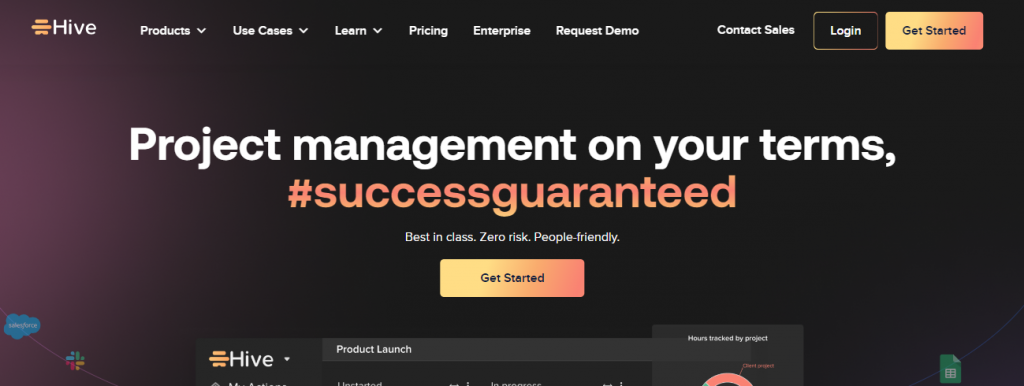
(Image Source: Hive)
Hive is one of the most affordable calendar task management software that I had the chance to use. With the calendar view in Hive, you can manage tasks and deadlines visually.
The software lets you choose how to display tasks from weekly to 6-week intervals. You can also show or hide weekends and take other subactions. The Hive calendar can be synced with other calendars for reminders and notifications. There, you can see project progress, health, and team workload.
Another thing that makes Hive stand out is flexible project hierarchies. I’ll explain about it briefly.
Hive lets you create subprojects, subfolders, and subactions within your main project. You can also assign different permissions, labels, and dependencies to each level of your hierarchy. This gives you more control and visibility over your project and makes it easier to manage complex workflows.
What you’ll like:
- Resource management to track team availability, workload, and utilization across projects
- Time tracking to monitor how much time is spent on tasks and projects
- Templates to replicate projects based on best practices and industry standards
- Proofing and approvals to review and comment on files and manage feedback
- Summary views to see an overview of all projects and tasks in a workspace
What you may not like:
- 200 MB of storage space in the free plan
- Bugs and glitches that affect the functionality and performance of the platform
Pricing: A free plan is available for up to 10 workspace members. Paid options start from $1/user/month.
10. Bitrix24 – Best for Remote Task Management
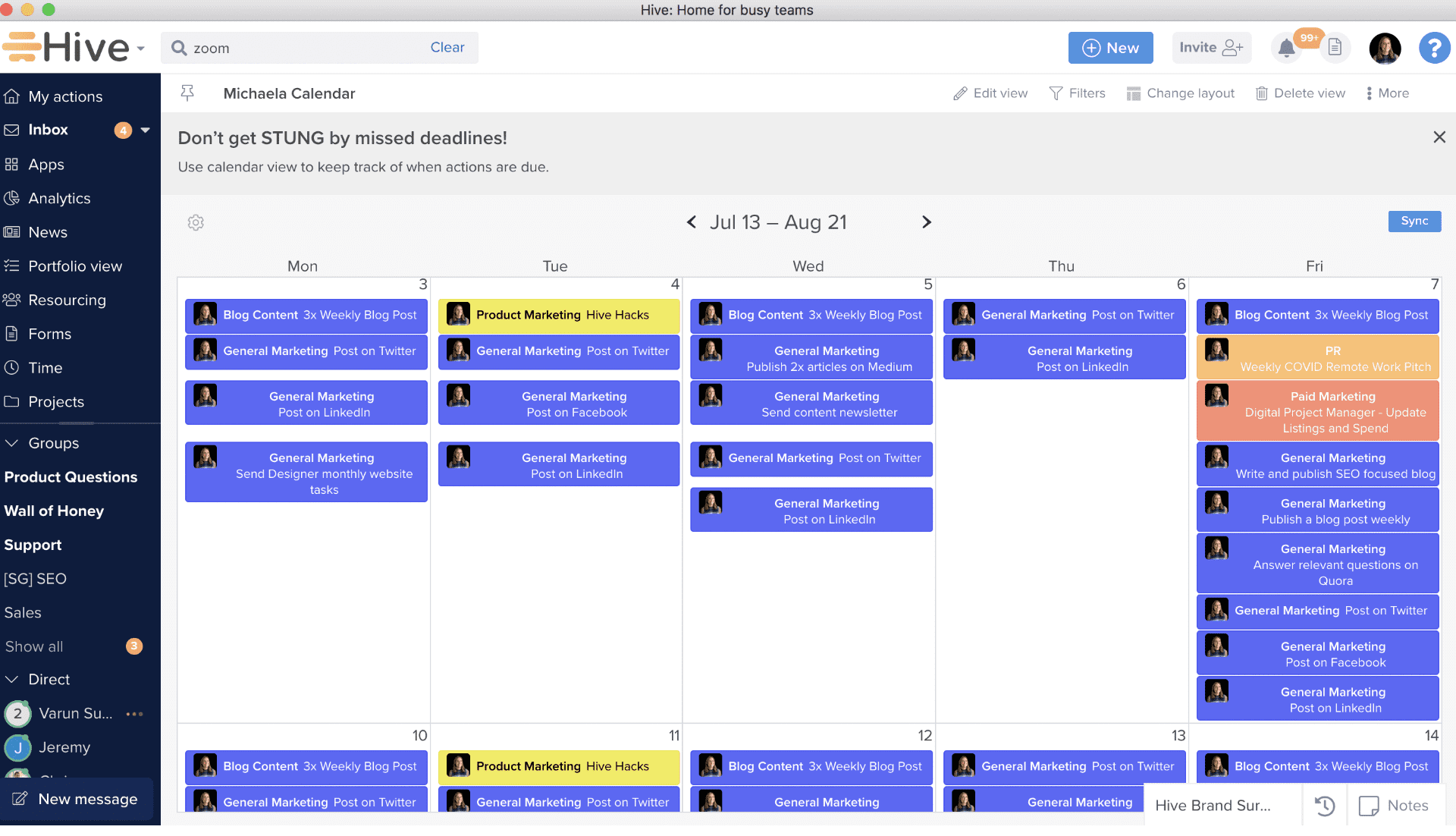
(Image Source: Bitrix24)
Last on the list, I have Bitrix24 – a calendar project management tool that lets you see and manage tasks in a graphical way. You can choose between day, week, or month views or use the schedule mode to see only your upcoming tasks.
You can also create new tasks or events by clicking on a date or modify existing ones by dragging and dropping them.
I also think the software is a perfect fit for remote teams looking for a task management tool. The software helps me keep my remote team connected and productive, no matter where they are.
You can create tasks and subtasks, set deadlines and priorities, attach files and comments, and monitor the workload and performance of each team member. The software lets you use Bitrix24’s built-in chat, video calls, and videoconferencing features to communicate with your team in real time.
What you’ll like:
- Task templates and automated workflows for recurring and routine tasks
- Email-to-task conversion and webmail integration for seamless communication
- Gantt charts and Kanban boards for visualizing progress and dependencies
- Report builder and advanced reporting for evaluating performance and results
- Polling and discussions for engaging team members and collecting feedback
What you may not like:
- Slow customer support response times
- No public file-sharing feature in the free plan
Pricing: A free plan is available with limited online storage space. Paid options start at $49/month (for 5 users).
Evaluation Criteria
The evaluation of products or tools chosen for this article follows an unbiased, systematic approach that ensures a fair, insightful, and well-rounded review. This method employs six key factors:
- User Reviews / Ratings: Direct experiences from users, including ratings and feedback from reputable sites, provide a ground-level perspective. This feedback is critical in understanding overall satisfaction and potential problems.
- Essential Features & Functionality: The value of a product is ascertained by its core features and overall functionality. Through an in-depth exploration of these aspects, the practical usefulness and effectiveness of the tools are carefully evaluated.
- Ease of Use: The user-friendliness of a product or service is assessed, focusing on the design, interface, and navigation. This ensures a positive experience for users of all levels of expertise.
- Customer Support: The quality of customer support is examined, taking into account its efficiency and how well it supports users in different phases – setting up, addressing concerns, and resolving operational issues.
- Value for Money: Value for money is evaluated by comparing the quality, performance, and features. The goal is to help the reader understand whether they would be getting their money’s worth.
- Personal Experience / Expert’s Opinion: This part of the evaluation criteria draws insightful observations from the personal experience of the writer and the opinions of industry experts.
So, these were my top picks for the best calendar task management software. Always remember to test whatever software you choose by going for a free trial or using the free plan. Having first-hand experience is a must before investing in a tool for long-term usage.
FREE. All Features. FOREVER!
Try our Forever FREE account with all premium features!






